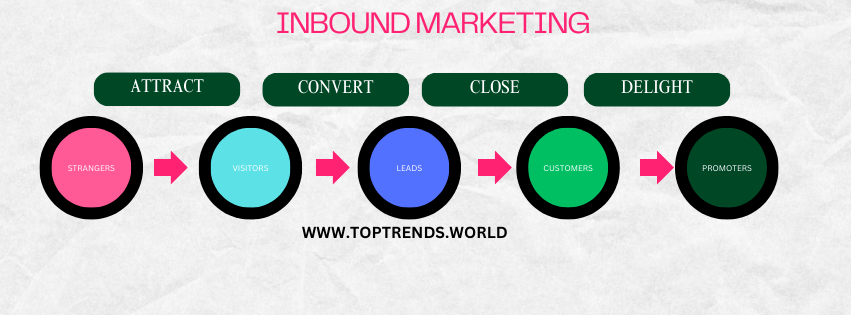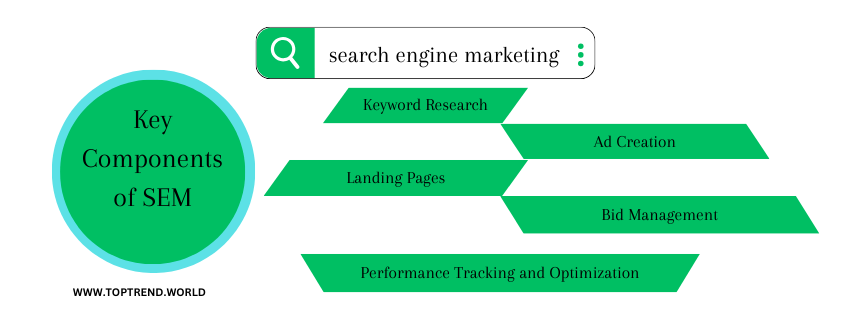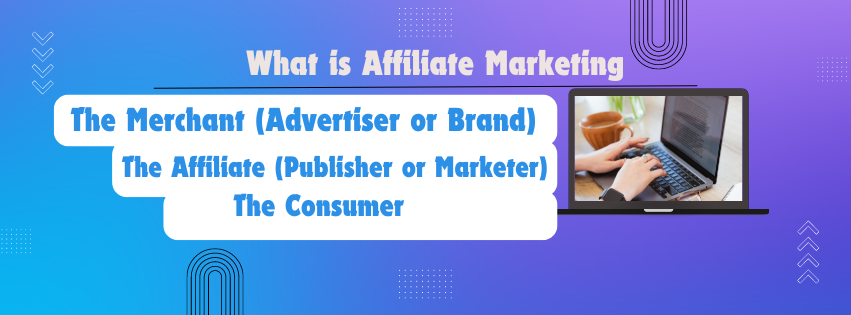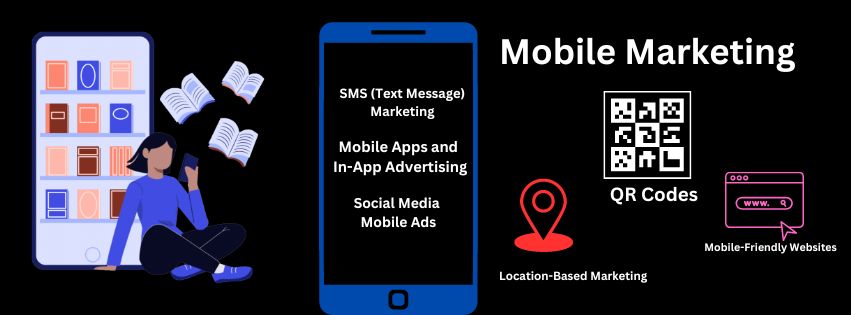Attracting and Engaging Customers Naturally
In an era where consumers are bombarded with advertisements and sales pitches, inbound marketing offers a refreshing approach to reaching and engaging your audience. Unlike traditional marketing methods that push messages to consumers, inbound marketing focuses on attracting customers through valuable content and meaningful interactions. This blog will explore the fundamentals of inbound marketing, its benefits, key components, and effective strategies to help you create a successful inbound marketing campaign.

What is Inbound Marketing?
Inbound marketing is a strategy that focuses on attracting potential customers to your brand through content and interactions that are relevant and helpful. Instead of interrupting consumers with unwanted ads, inbound marketing aims to provide value and build trust, turning strangers into customers and promoters of your brand.
The Inbound Marketing Methodology
The inbound marketing methodology consists of four key stages:
- Attract: Drawing the right people to your website or business using valuable content and engaging interactions.
- Convert: Transforming visitors into leads by capturing their contact information through forms, landing pages, or calls-to-action (CTAs).
- Close: Nurturing leads and converting them into customers through targeted communication and personalized offers.
- Delight: Providing exceptional customer service and ongoing support to turn customers into loyal advocates of your brand.
Key Benefits of Inbound Marketing
- Cost-Effective: Inbound marketing is more cost-effective than traditional outbound marketing methods, offering a higher return on investment (ROI).
- Builds Trust and Credibility: By providing valuable content and information, inbound marketing helps build trust and credibility with your audience.
- Long-Term Results: Inbound marketing strategies, such as content creation and SEO, provide long-term results and continued traffic and lead generation.
- Targeted and Personalized: Inbound marketing allows for targeted and personalized communication, ensuring your message reaches the right audience at the right time.
- Measurable and Data-Driven: Inbound marketing offers access to real-time data and analytics, enabling you to measure the effectiveness of your campaigns and make data-driven decisions.
Key Components of Inbound Marketing
1. Content Marketing
Content marketing is the cornerstone of inbound marketing. It involves creating and distributing valuable and relevant content to attract and engage your target audience.
- Blogging: Writing informative and engaging blog posts on topics relevant to your audience to attract organic traffic and establish your brand as an authority in your industry.
- Videos: Creating video content to educate, entertain, or inspire your audience, increasing engagement and shares.
- Infographics: Using visual representations of data or information to simplify complex topics and make them more digestible.
- E-books and Whitepapers: Offering in-depth guides or reports that provide valuable insights and information to your audience.
2. Search Engine Optimization (SEO)
SEO is the process of optimizing your website and content to rank higher in search engine results pages (SERPs). It helps improve your website’s visibility and attract organic traffic.
- Keyword Research: Identifying the keywords and phrases your target audience uses to search for information related to your industry or products.
- On-Page SEO: Optimizing individual web pages for specific keywords, improving content quality, and enhancing the overall user experience.
- Technical SEO: Ensuring your website is optimized for search engine crawlers, focusing on site speed, mobile-friendliness, and secure connections.
- Link Building: Acquiring high-quality backlinks from reputable websites to increase your site’s authority and credibility.
3. Social Media Marketing
Social media marketing involves promoting your brand and content on social media platforms to increase brand awareness, drive traffic, and generate leads.
- Organic Social Media: Posting content and engaging with followers on platforms like Facebook, Instagram, Twitter, LinkedIn, and TikTok.
- Paid Social Media: Running targeted ad campaigns to reach a larger and more specific audience.
- Social Listening: Monitoring social media conversations and mentions to gain insights into your audience’s preferences and opinions.
4. Email Marketing
Email marketing involves sending targeted emails to a list of subscribers to promote products, share updates, or nurture relationships.
- Newsletters: Regular updates sent to subscribers, covering news, tips, and promotions.
- Automated Email Sequences: Pre-set emails sent based on specific triggers, such as a user signing up or making a purchase.
- Personalized Emails: Tailoring email content to the recipient’s preferences, behavior, or past interactions with your brand.
5. Lead Generation and Conversion
Lead generation and conversion are critical components of inbound marketing. They involve capturing and nurturing leads to convert them into customers.
- Landing Pages: Creating dedicated pages on your website for specific offers or promotions to capture leads’ contact information.
- Calls-to-Action (CTAs): Using buttons, banners, or links to encourage visitors to take a specific action, such as signing up for a newsletter or downloading an e-book.
- Forms and Surveys: Collecting information from visitors to better understand their needs and preferences and tailor your marketing efforts accordingly.
6. Marketing Automation
Marketing automation involves using software and tools to automate repetitive marketing tasks, such as email campaigns, social media posting, and lead nurturing.
- Workflow Automation: Setting up automated workflows that trigger specific actions based on user behavior or interactions.
- Lead Scoring: Assigning scores to leads based on their interactions with your brand to prioritize and focus on high-quality leads.
- Personalization: Delivering personalized content and offers to leads based on their behavior and preferences.
Effective Strategies for Inbound Marketing
1. Define Your Buyer Personas
Understanding your target audience is crucial for creating effective inbound marketing strategies. Develop detailed buyer personas that represent your ideal customers, including their demographics, goals, challenges, and preferences. Use these personas to tailor your content and marketing messages.
2. Create High-Quality Content
Content is at the heart of inbound marketing. Create high-quality, engaging content that provides value to your audience and aligns with your brand message. Whether it’s blog posts, videos, infographics, or social media updates, your content should be relevant and informative.
3. Optimize Your Website for SEO
Ensure your website is optimized for search engines to improve visibility and attract organic traffic. Focus on keyword research, on-page SEO, technical SEO, and link building to enhance your website’s performance and rankings.
4. Leverage Social Media
Social media is a powerful tool for connecting with your audience and building brand awareness. Choose the social media platforms that best align with your target audience and business goals. Engage with your audience by responding to comments, messages, and reviews.
5. Use Data to Drive Decisions
Regularly analyze your inbound marketing data to measure performance, identify trends, and make data-driven decisions. Use tools like Google Analytics and marketing automation software to track website traffic, user behavior, and conversion rates. Adjust your strategies based on the insights you gather.
6. Personalize Your Marketing
Personalization can significantly improve engagement and conversion rates. Use customer data to personalize emails, content, and offers. This can include addressing customers by their name, recommending products based on their past purchases, or tailoring content to their interests.
7. Implement Lead Nurturing Campaigns
Lead nurturing is a critical component of inbound marketing. Develop automated email sequences and personalized content to nurture leads through the sales funnel. Provide valuable information and resources to help leads make informed decisions.
8. Test and Optimize
Continuously test different aspects of your inbound marketing campaigns, such as ad copy, email subject lines, and website design. Use the results to optimize your efforts for better performance. A/B testing is a valuable technique for identifying what works best for your audience.
9. Stay Updated with Trends
Inbound marketing is constantly evolving, with new technologies and trends emerging regularly. Stay updated with the latest developments in the industry to ensure your strategies remain effective and competitive.
10. Integrate Your Marketing Efforts
Ensure that your inbound marketing efforts are integrated across different channels and platforms. This creates a cohesive brand experience for your audience and maximizes the impact of your marketing campaigns.
Tips for Success in Inbound Marketing
- Be Consistent: Consistency in your branding, messaging, and content helps build trust and recognition among your audience.
- Focus on Quality: Prioritize quality over quantity in your content and advertising efforts. High-quality content and ads are more likely to engage and convert your audience.
- Build Relationships: Inbound marketing is not just about selling; it’s about building relationships with your audience. Engage with your audience, respond to their feedback, and provide value beyond your products or services.
- Monitor Competitors: Keep an eye on your competitors’ inbound marketing strategies to identify opportunities and stay ahead of the curve.
- Stay Flexible: Be prepared to adapt your strategies based on changing market conditions, audience preferences, and technological advancements.
Conclusion
Inbound marketing offers a powerful and cost-effective way to attract, engage, and delight customers. By understanding the key components and strategies of inbound marketing, you can create effective campaigns that achieve your business goals. Remember to stay flexible and adapt your strategies as the digital landscape continues to evolve.
This blog provides a comprehensive overview of inbound marketing, making it a valuable resource for businesses and marketers looking to enhance their online presence and achieve success in the digital world.





One thought on “The Ultimate Guide to Inbound Marketing”